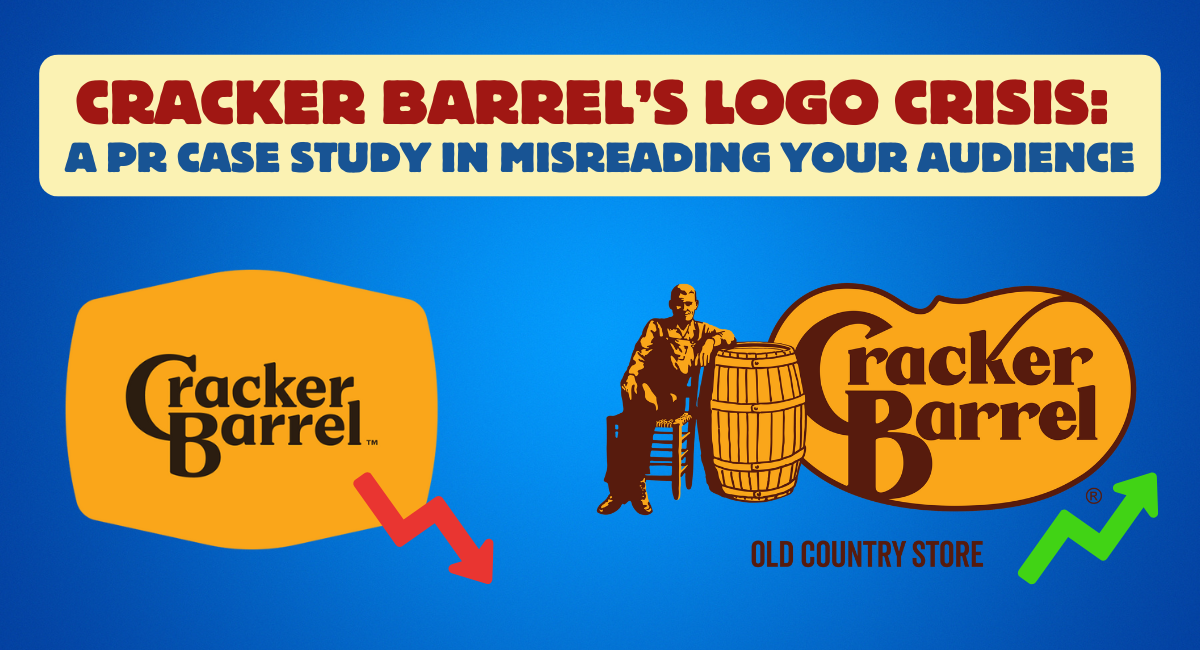Cracker Barrel’s Logo Crisis: A PR Case Study in Misreading Your Audience

When Cracker Barrel quietly rolled out a refreshed logo last week, executives probably expected a warm welcome for their modernized, simplified brand identity. Instead, they got a masterclass in how quickly brand updates can spiral into a full-blown PR crisis.
Here’s what happened — and what PR pros can learn.
1. The Rollout: A Modern Refresh That Erased Tradition
On Aug 21, 2025, photos emerged of a new Cracker Barrel logo in New York. The refreshed design stripped away the long-time “Old Timer/Uncle Herschel” figure, leaving a pared-down, text-centric look.
The intent was part of a wider modernization effort — menu tweaks, store redesigns, and an attempt to appeal to younger demos. But for a brand whose identity rests heavily on nostalgia and Americana, the change was seismic.
2. Backlash: Social Media & Cultural Identity
Almost immediately, social media lit up with complaints. Words like “generic,” “corporate,” and “brand suicide” trended, with conservative commentators amplifying the criticism.
This wasn’t just aesthetic pushback — it tapped into identity politics. In the wake of Bud Light’s 2023 controversy, Cracker Barrel’s move was framed as another brand “losing touch with its roots”.
3. Company Response: Apology & Listening Language
By Mon, Aug 25, Cracker Barrel issued a statement:
“We could’ve done a better job sharing who we are and who we’ll always be.”
The message leaned on humility and emphasized continuity, but notably didn’t commit to reversing course yet.
4. Escalation: Trump Weighs In
Then came the political accelerant. On Tue, Aug 26, Donald Trump posted on Truth Social urging Cracker Barrel to “admit a mistake and return to the old logo.”
That alone might have been enough to dominate the news cycle. But according to multiple reports, a deputy White House chief of staff claimed Cracker Barrel called to thank Trump for his support.
Now the story wasn’t just about design — it was a culture-war flashpoint with national political stakes.
5. The Reversal: Listening, or Capitulating?
By Tuesday evening, Cracker Barrel announced it was scrapping the new logo:
“Our new logo is going away and our ‘Old Timer’ will remain. We said we would listen, and we have.”
What had begun as a visual refresh ended as a very public retreat.
6. Market Reaction: From Plunge to Recovery
Investors reacted sharply. Shares dropped 12–15%, wiping out nearly $100M in market cap, before bouncing back 3–8% after the reversal.
Polls also suggested damage to consumer perception: a YouGov survey found 29% of U.S. adults said the logo change made them less likely to dine there, while 59% said unaffected.
7. Leadership & Reputation Fallout
Media commentary questioned whether CEO Julie Felss Masino and leadership misread the brand’s base, with some critics (notably investor Sardar Biglari) calling for accountability.
Analysts framed it as another cautionary tale of ignoring cultural context in branding — the same trap Bud Light fell into. For Cracker Barrel, the “safe” path of modernization turned into an identity crisis.
Lessons for PR & Comms Teams
- Know Your Core Audience
Modernization is fine, but not at the expense of what your most loyal customers hold sacred. - Pilot Before Launching Nationally
A/B testing logos in a few markets or floating concepts publicly could have flagged the backlash risk earlier. - Prepare a Crisis Playbook
The fast apology and reversal show some preparedness, but the messaging was reactive. A clearer, proactive stance might have softened the backlash. - Beware Political Catalysts
Once political figures enter the chat, brand crises escalate. Every comms pro must factor political amplification into risk assessments.
Final Thought:
Cracker Barrel’s crisis isn’t just about a logo. It’s about the collision of branding, identity politics, and consumer expectations in 2025.
The Old Timer lives on — but the incident is a reminder: in today’s media landscape, logos aren’t just logos, they’re cultural statements.
Angus Nguyen
Angus Nguyen is the Director of Marketing at Fullintel and a proud member of the “I read the AI Overviews so you don’t have to” club. He spends his days obsessing over media measurement, digital trends, and why your best-performing PR story might be invisible to AI. With 7+ years of experience in brand strategy and media intelligence, Angus helps comms teams future-proof their visibility in an AI-first world. When he’s not decoding Google’s latest algorithm update, he’s probably hunting down the best bánh mì in Toronto—or creating viral content about it.
📌 Follow Angus for fresh takes on AI media monitoring, PR analytics, and the future of brand visibility.
Angus Nguyen, Director of Marketing at Fullintel, specializes in data-driven public relations and media monitoring. His experience analyzing media trends and their global impact provides insights into PR challenges in the automotive sector amid geopolitical developments. Angus excels at separating signal from noise, helping brands focus on actionable insights for stakeholder communication and crisis management.


